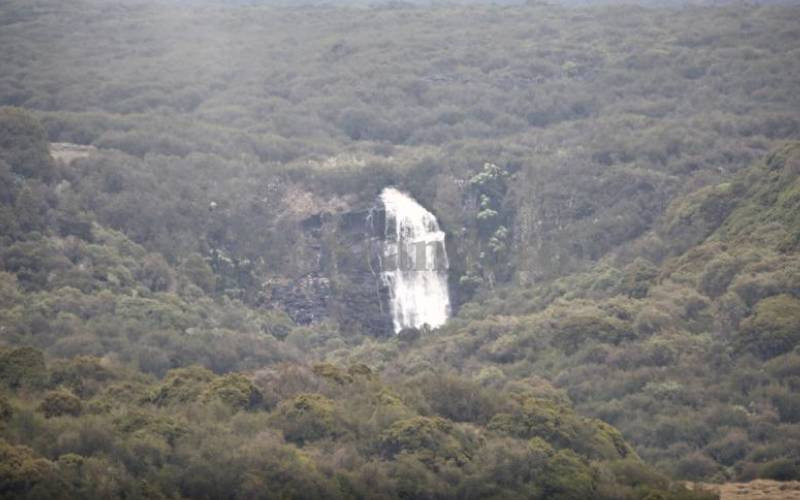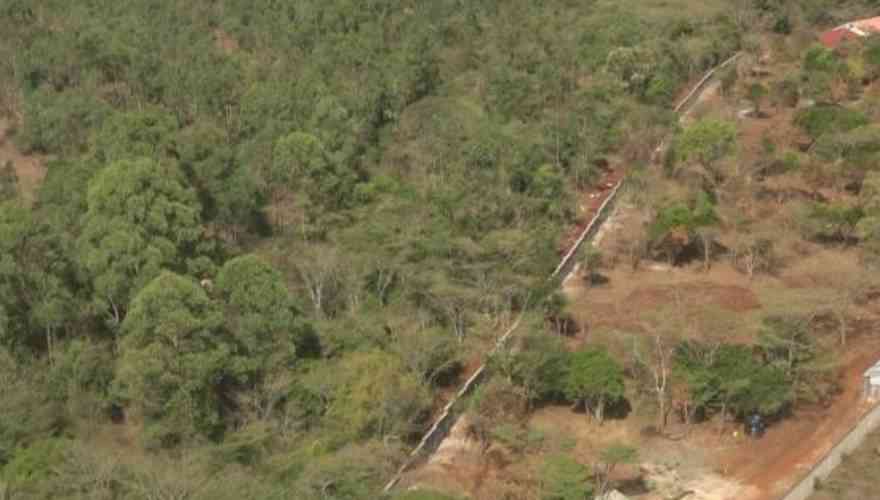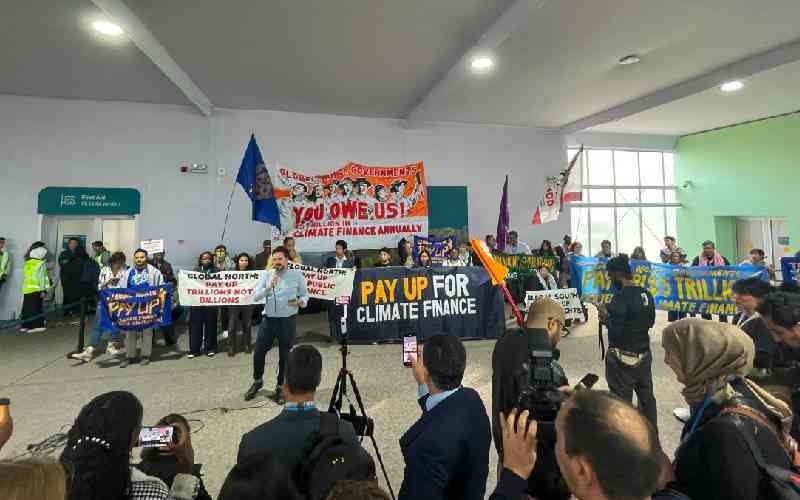
It is mid-morning in the heart of Aberdares Forest National Park, and sunlight filters through the dense canopy in intermittent bursts.
Colourful birds chirp from the treetops, while crickets create a cacophony in the lush and undisturbed ecosystem.
The park is characterised by majestic peaks, steep ravines, captivating waterfalls, and expansive moorlands, providing a perfect environment for numerous species of wildlife. Among them are the endangered mountain bongos, elephants, black rhinos, leopards, buffalos, and many others.
Conservationists warn that this tranquil environment may soon be irreversibly altered if the government proceeds with the proposed upgrade of the Ihithe - Aberdare Forest - Kahuruko - Ndunyu Njeru Road, popularly known as the Mau Mau Road, which cuts through the forest.
The project has sparked a fierce debate between those in favour and those against it.
"The main concern of having a highway traversing the Aberdare mountain ecosystem is that it will divide the ecosystem in two, fragmenting the most vital forest ecosystem and crucial water tower.
"This will lead to degradation, forest destruction, and increased wildlife fatalities," said Christian Lambrechts, CEO of Rhino Ark.
The forest serves as one of the main water catchment areas in the country, providing water to the Tana River, which in turn supplies the seven Forks hydroelectric power plants generating 55 per cent of Kenya's electricity.
- We need to talk to our children about climate change
- Day out with the trash trackers of Mukuru slums
- Climate justice and conservation are undeniably interconnected
Keep Reading
It also acts as the catchment area for Sasumua and Ndakaini dams, which supply water to Nairobi. Furthermore, the forest is the source of the Tana and Athi rivers, which eventually flow into the Indian Ocean.
It also feeds the Ewaso Nyiro River, which runs through Lorian Swamp, and the River Malewa, which drains into Lake Naivasha.
"The Aberdare is not merely a national park or a forest reserve; it is a global park because it is home to globally significant species that are of international interest. Without the Aberdare, Kenya would disappoint the global community," said Paul Matiku, Director of Nature Kenya.
According to the Environmental and Social Impact Assessment (ESIA) report, approximately 104 hectares of vegetation lie within areas that may potentially be cleared. This includes 75 hectares of bamboo, 14 hectares of forest, and another 14 hectares of moorland that are at risk of destruction.

During the burial of Mukami Kimathi, the wife of freedom fighter Dedan Kimathi, in Nyandarua County, some leaders called on President William Ruto to resume the construction of the Sh4.4 billion road that connects Nyandarua and Nyeri counties.
"Mr. President, kindly allocate the funds for the construction of the road. They claim that it will harm the animals, but as the Chairperson of the Lands, Forestry, and Wildlife Committee in the Senate, I assure you that no harm will come to the animals," said Senator John Methu of Nyandarua.
In response, the President said, "You've asked me about the Ndunyu Njeru road, which passes through Nyeri and cuts through Aberdare forest. Some people have taken us to court over environmental concerns. Senator Methu, I request you to persuade them to drop the case, and I will allocate the necessary funds," Ruto said.
Deputy President Rigathi Gachagua has also been vocal in advocating for the construction of the road, emphasising its significance in establishing market linkages between Nyeri, Murang'a, and Nyandarua counties.
Conservationists have strongly opposed the project, saying the negative impacts the road will have on the delicate ecosystem outweigh any potential benefits.
Organisations such as Rhino Ark Charitable Trust, Nature Kenya, and the National Environment Civil Society Alliance of Kenya have all come out strongly against the project.
The conservationists point out that Aberdare National Park and its moorlands are home to a significant population of elephants, which are globally endangered species.
According to a 2017 report titled "Elephant Survey, Aberdare Conservation Area," conducted by the Wildlife Conservation Society and Rhino Ark, with support from the Kenya Wildlife Service and the Kenya Forest Service, the estimated elephant population in the Aberdare ecosystem is 3,568.
The moorlands, which will be divided by the proposed upgraded road, have a medium to high concentration of elephants. This population represents nearly 10% of the total elephant population in Kenya.
"In addition to elephants, we have the critically endangered mountain bongo antelopes, with less than 80 remaining in the world. All of them are in Kenya, and between 40 to 50 of them inhabit the area that will be crossed by the road," said Lambrechts.
The conservationists base their argument on a comprehensive study conducted in 2020 by the University of Nairobi, the University of Oxford, and the University of Amsterdam, which evaluated the socio-economic potential of road development projects around the Aberdare range.
The study concluded that the proposed road upgrade would bring minimal socioeconomic benefits.

"I believe it is one of the most well-executed studies ever conducted, and its findings indicate that there are alternative roads that are superior to the proposed road. The proposed road will not connect any additional people to a tarmac road, nor will it provide any gains in terms of transit times," added Lambrechts.
The study showed the road would not reduce travel times, as vehicles would have to navigate steep gradients to reach an altitude of 3,200m in the moorlands and then descend on equally steep gradients.
"The road is an ecological disaster. It will fragment the forest, making it impossible for wildlife to cross, and fast-moving vehicles would pose a threat to animals attempting to cross. This road will put tremendous strain on vehicles due to its steep gradient. If there are any benefits to the Mau Mau Road through the Aberdares, they are minimal," said Matiku.
The National Environment Civil Society Alliance of Kenya (NECSA-K), in a memo to the National Environmental Management Authority (NEMA), also expressed concerns about the anticipated impacts of the road, including the felling of indigenous trees and vegetation, hindrance to wildlife movements, wildlife poaching, pollution, and wetland drainage.
These impacts are deemed to have far-reaching ecological and social implications, some of which are irreversible.
This is not the first time the construction of the road has been opposed. On October 27, 2009, NEMA refused to approve the project, citing its significant impacts on the forest. Kenya Wildlife Service, Kenya Forest Service, African Wildlife Foundation, Rhino Ark, Kenya Tourism Federation, and the East Africa Wildlife Society had all strongly opposed the project at that time.
"The authority is unable to issue an Environmental Impact Assessment Licence for the project. You are advised to redesign your plans to explore alternative sites," read the letter by NEMA to the Ministry of Roads.
Speaking during a tree planting exercise at Karura Forest, Environment and Forestry Cabinet Secretary Soipan Tuya said there is a need to carefully consider the issue before reaching a definitive decision.
"The Ministry's stance is that there must be a clear demonstration of the absolute necessity to construct a road through the Aberdare Forest. NEMA has not yet provided its position. We recently had a discussion with parliament, and my view is that we need to explore alternative options before granting any approval," she said.
 The Standard Group Plc is a multi-media organization with investments in media platforms spanning newspaper print
operations, television, radio broadcasting, digital and online services. The Standard Group is recognized as a
leading multi-media house in Kenya with a key influence in matters of national and international interest.
The Standard Group Plc is a multi-media organization with investments in media platforms spanning newspaper print
operations, television, radio broadcasting, digital and online services. The Standard Group is recognized as a
leading multi-media house in Kenya with a key influence in matters of national and international interest.











